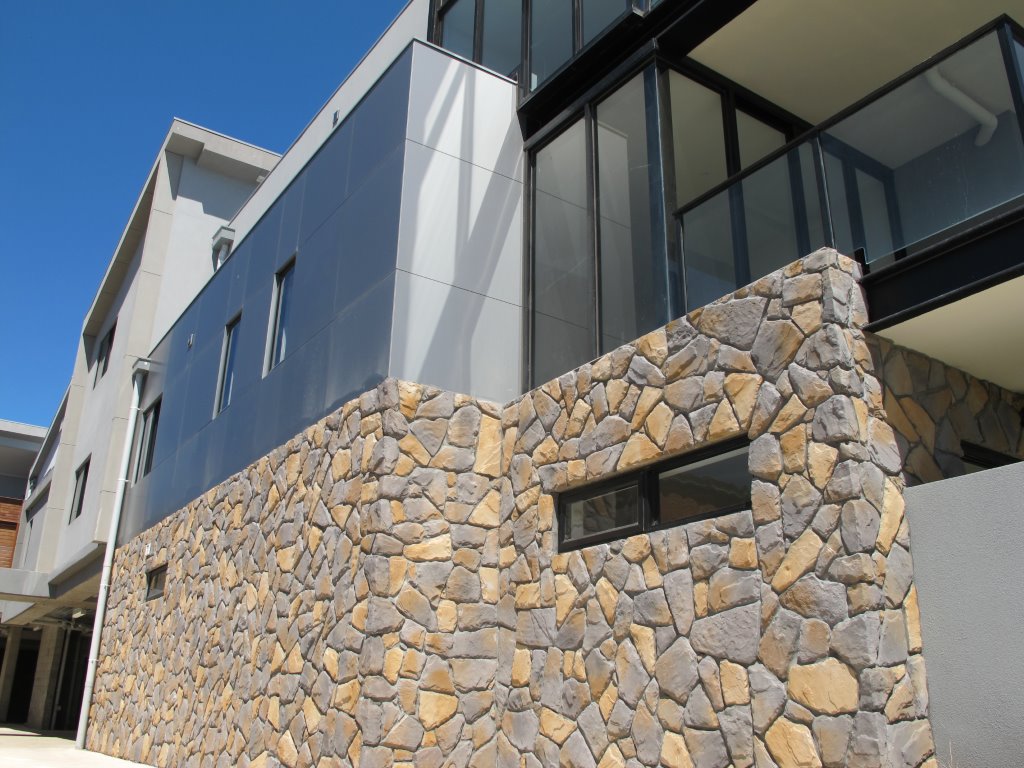Basic Helpful Tips
- Prior to installing InfintiStone, it is important to decide whether waterproofing is required on your substrate. All wall boarding joins and screw holes should be sealed properly. If in doubt, consult your nearest board manufacturer. We recommend masonry substrates for natural split stone due to weight.
- Ensure to leave a expansion joints between abutting surfaces eg start 10mm off floor.
- Start your Corners first, alternating the long and short returns as you work upwards.
- Be sure to keep the work level as you go for stacked stone. Snap a chalk line or use a spirit level to check every few rows.
- Use a trowel edge, nipper or other sharp, blunt tool to trim stones. For straight cuts, use a grinder with a diamond or masonry blade.
- Conceal trimmed edges with grouting where applicable, or hide them by turning the cut side upward above eye level or downward below eye level.
- Avoid long sections of straight, unbroken grout lines in standard grout installations. Be sure to use a consistent joint width. A 12mm width is standard.
- When installing in a dry, hot climate or onto extremely dry surfaces, be sure to wet the stone and the wall first so they do not absorb moisture from adhesive. You can spray or otherwise apply water onto the back of the stone or dip it into water. Spray or brush water onto the wall as well. Allow both to dry a few minutes to remove excess water.
- For Adhesives, if using Mapei Keraflex pre-mix Adhesive (or Equivalent), ensure to wipe off excess from face of stone immediately with a Wet Sponge otherwise it may be difficult to clean off when dry.
- For Grouting, if Mapei Keracolour GG Grout (or Equivalent) is used and accidentally gets on the face of stone during installation, do not wipe it off. It will smear and discolour the stone. Instead, let it set until ‘touch dry’ – typically around 20-40 minutes dependent on weather, then brush it away with a dry heavy duty bristle broom.
- Avoid water runoff onto your installation. Divert water away with flashing.
- Do not install below water level, and do not expose stone to chemicals such as chlorine etc, as it will stain the stone.
- Do not use wire brushes or acid on the stone surface.
- Local building codes vary. Be sure to check the requirements in your area.
- Lay out the stone near your work area first. As you install, choose stone that vary in colour tones, shape and size for best result.
- Apply typically 10-15mm thick adhesive bed to the back of the stone, then rub the stone against your substrate is a gentle back-and-forth motion until the adhesive squeezes out around the edges. As a guide, 5-6mm final adhesive bed is ok. Check with adhesive manufacturer if in doubt.
Standard Grout Installation Tips:
- Apply all stone to wall, let it set, then use a grout bag to fill in the joints with grout.
- Grout/mortar joints typically take 20 to 60 minutes to ‘Touch Dry’ – this depends on weather. When they do, use a striking tool to scrape or rake out the excess grout at a consistent depth while smearing it along the joint seams for a good seal.
- Smooth the joints and brush any loose grout/mortar with a whiskbroom.
- IMPORTANT – never sponge wet grout over stone as this will smear over the stone face. If there is accidental excess onto face of stone, leave until touch dry then simply use a heavy duty bristle broom to clean off.
Drystack Installation Tips:
- Drystack stone may need to be moistened before installation, as described in the Basic Installation Hints above.
- Lay out the stone near your work area. As you install, choose stones that vary in colour, shape and size.
- Apply stone from the bottom up.
- Apply a 10-15mm layer of adhesive to the entire back of the stone. Rub against substrate in a gentle back-and-forth motion until the adhesive squeezes out around the edges. Overall adhesive bed of 5-6mm is typical.
- Remove any excess adhesive around the edges and pack it into gaps along the stone’s edges.
- IMPORTANT TIP – with pre-mixed adhesives, always wipe any excess over stone facing with a wet sponge without delay.
- Once you finish applying all stone, touch up as necessary to hide cuts or fill voids as desired.
Important Notes:
- Please refer to our Website Terms & Conditions prior to using any materials & publications from this page. By using the above information you agree to be bound by our Terms and Conditions.
- Cladding directly onto wall boards may void wall board manufacturer’s warranties.
- For walls exceeding head height, we recommend to consider metal mesh preparation over wall boards or shelving brackets for even distribution of weight. Check board manufacturers for technical information.



